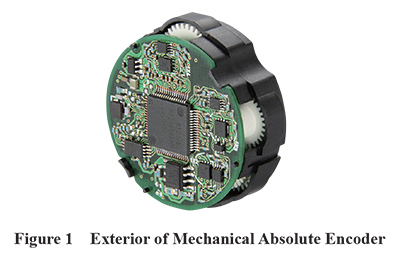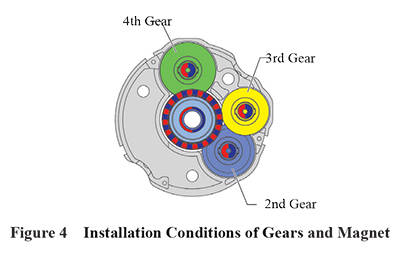Development of the Battery-Free Multi-Rotation Absolute Mechanical Encoder
In recent years, greater accuracy, better reliability, and safety are demanded of motors, especially motors used in critical positioning applications. Such systems typically utilize servo motors with encoder feedback along with battery backup, allowing it to perform closed loop absolute control. From these requirements, a battery-free, multi-rotation absolute mechanical encoder was developed. The AlphaStep AZ Series, a closed loop system, adopted this type of sensor and is currently on the market today.
1. Introduction
Oriental Motor has created a product that retains positioning information, even when the main power supply is suddenly turned off. With this ability built-in, retaining information within the system allows for a reduction of sensors and improves reliability. Also incorporated into this system is the ability to monitor the motor and also the driver along with standard features for safety. Historically, the structure of a mechanical sensor is very complex. They were expensive and large in size. For these reasons, the mainstream sensor, even today, is the battery backup system, which are common in absolute systems.With battery based systems, the retention period of positioning information after losing the main power supply depends heavily on the capacity of the battery. Battery maintenance is also an issue as batteries wear out, need to be replaced and disposed of properly. The solution to these problems is now found in an robust, highly reliable system that provides feedback regardless of the time the power has been turned off, for example in a safety situation or transporting the equipment overseas. This feature eliminates the need for batteries, additional sensors, complicated wiring and provides the confidence for long term service needed in today’s advanced equipment.
Oriental Motor started designing the mechanism that employs high-precision resin parts, while focusing on the aspect of a compact body. By incorporating the magnetic sensor, which has rapidly progressed in recent years, Oriental Motor has successfully developed a multi-rotation absolute encoder that is compact and affordable (patent pending). This is called the "Mechanical Absolute Encoder" (Refer to Figure 1), and it is featured on the AZ Series motor and driver combinations and is part of geared or actuator solutions.

The AZ Series, equipped with the Mechanical Absolute Encoder, not only inherits characteristics of the alpha step such as being "Tuning-Free" and having "High-Efficiency", but also realizes the multi-rotation absolute system without batteries (Refer to Figure 2).

2. Mechanical Absolute Sensor: Principle of Position Detection and Structure
The Mechanical Absolute Encoder detects coordinates within 1 rotation (360°) with a magnet installed at the center of the motor shaft and a magnetic sensor installed on a circuit board, which is placed directly above the magnet. This special kind of magnet contains 2 poles in the center and multiple poles on the outer edge (refer to Figure 3). A coordinate is detected by reading the direction of the magnetic flux and phase difference generated by the poles at the center and outer edge. This is to calculate accurate position coordinates.

There are a total of 4 gears containing magnets configured in such a way that the 1st gear drives the 2nd and 4th gear, while the 2nd gear drives the 3rd gear (Refer to Figure 4).

Each gear consists of different tooth counts and therefore, the phase differences between gears change every time the motor shaft rotates. By utilizing the phase differences, which are caused by the ratio of teeth numbers, the gear phase difference is detected in increments of 1 tooth (1 pitch). Based on the combination of phase differences, the multi-rotation coordinate is calculated (Refer to Figure 5).

It is possible to detect backlash as long as it is within 1 pitch. However, besides backlash, errors in coordinate detection can be due to the interference of magnetic force when multiple magnets are placed too close to one another, or caused by parts accuracy malfunction. Considering these aspects, the designed value of backlash is even smaller than 1 pitch of a gear.
The phase differences of all gears are designed to return to their initial states after rotating 1,800 times. With this feature, it is possible for the Mechanical Absolute Sensor to detect multi-rotation coordinates for up to 1,800 rotations. The number of 1,800 rotations, which are the detectable multi-rotation coordinates, is the common multiplier of gear ratio variations for Oriental Motor products and thus, it makes it easy to control coordinates at the gearhead output shaft.
The following example is used to further explain the multi-rotation detection principle: Let's assume that there are 9 teeth on the drive side gear, and 10 teeth on the non-drive side gear. When the drive side gear rotates once, the non-drive side gear rotates 324°, which is 36° (360°/10) less and is the angle of one tooth. When repeating the rotations, the positioning relationship of these gears shift 36° per rotation, and they return to their initial states after 10 rotations.
When using the combination of these gears, the multi-rotation coordinates for 10 rotations can be detected. The principle of the detection of multi-rotation coordinates from phase differences of several gears is similar to the principle of how to make the timing from the combination of angles (phase differences) of the hour hand, minute hand and second hand of a clock.
Due to the following reasons, resin materials are used for the gears and the encoder enclosure:
- The Mechanical Absolute Encoder employs magnets and a magnetic sensor. If magnetic materials are used for the structure, they interfere directions of magnetic flux and thus, position detection becomes very difficult. Because resins are non-magnetic materials, they do not interfere with detection accuracy.
- Resins have a self-lubricating characteristic and are excellent for wear and abrasion resistance.
- Compared to precious metal materials, resins can make the motor mass, including the encoder, become lighter, and the inertia moment of the gear mechanism become smaller.
- In order to make the encoder itself compact, its structure was designed to make the circuit board mounted with a magnetic encoder become closer to the gear mechanism. When using conductive materials, it may cause the electric circuit to be shorted out if frictional dust is generated.
- The structure would become too complicated when trying to prevent frictional dust from entering into the electric circuit resulting in increase of parts cost and worsening of productivity.
3. Durability of Mechanical Encoder
As explained earlier, the Mechanical Absolute Encoder utilizes the multi-rotation position detection by employing the gear mechanism. The gears in the Mechanical Absolute Encoder are used for the purpose of multi-rotation position detection by creating phase differences among the gears, but not for the purpose of power transmission. For this reason, they are driven under nearly no loads. For the materials of these gears, resins, which have a self-lubricating characteristic and are excellent for wear and abrasion resistance, and the grease exclusively for resins, are used for high durability.
From the standpoints of abrasion resistance and impact resistance, the following tests of uni-directional continuous operation and instantaneous bi-directional operation were conducted, in order to confirm high durability of the gears.

By measuring backlash within the specified period under the above conditions, the gear's tooth surface wear volume was tested. As a result, no deterioration with time for backlash was detected.

The test was conducted under the conditions above. Just as the test result from Test 1, no increase of backlash between gears, or no deterioration with time was detected.
4. Features of the AZ Series with Mechanical Absolute Encoder
The AZ Series is a closed loop stepper motor package equipped with the newly developed Mechanical Absolute Encoder, which uses the multi-rotation absolute system without batteries. The Mechanical Absolute Encoder detects absolute coordinates, enabling the motor to have a home position. Therefore, it is not necessary to do return-to-home operations. Even if a return-to-home operation is required, an external sensor is not needed since the motor has its own home position. In general, when conducting a highly accurate return-to-home operation with an external sensor, it is necessary to do it at very low speed while considering the sampling cycle of the sensor's ON/OFF detections. Depending on circumstances, this takes a long period of time. Also, in order to improve the return-to-home accuracy, it takes a little ingenuity, for example, by combining the external sensor with the Z phase signal (Refer to Figure 6), or using a return-to-home push motion operation.

When using the AZ Series product, a user does not need to worry about speed or encoder accuracy. The speed limit of the return-to-home operation can be freely set within the range that the motor can drive. Also, it is possible to conduct a return-to-home operation while retaining the positioning accuracy of the motor (Refer to Figure 7).

In addition, with a conventional control motor, an optical encoder is often used as a sensor (limit sensor, etc.) installed on the equipment. However, oil mist or dust in the air sometimes causes an optical encoder to malfunction or recognize falsely. By using the AZ Series product, a need for an encoder is eliminated, resulting in less encoder related failures . The elimination of an encoder is also cost saving due to the elimination of wires. The labor required to wire the encoder is no longer needed. When setting an equipment home position with an external encoder, it is necessary to install the encoder at the targeted location, which may require subtle adjustments of the distance. On the contrary, the AZ Series can easily select and set any given position as home position by using the "Home Position Reset Function". With the AZ Series, a user can not only avoid having equipment adjustments, but also eliminates adjustment costs.
5. MONITORING
The AZ Series is capable of monitoring driver and motor information, and relaying the information when requested. The monitoring capability can be broken down to 3 main categories: Driver data, Operation data, and Alarm History.
Driver data contains information such as drive name, serial number, power cycle count, power supply voltage, communication settings and even dip switch settings. Operation data contains information related to motor motion such as: motor position, motor speed, motor/drive temperature, torque monitor. The alarm history data contains a list of malfunctions, a timestamp, and details of what happened during that failure. The driver will provide specific information codes so that the issue can be quickly isolated.
By using the available information provided by the driver you can monitor the motor and evaluate the performance of the system. This information can be easily retrieved by PC, HMI, or PLC via the RS-485 communication port.
DRIVER DATA
The AZ Series Driver has a built in serial communication protocol (MODBUS RTU). Serial communication allows user to retrieve drive data.
6. Summary
The AZ Series equipped with the newly developed Mechanical Absolute Encoder allows for the battery-free multi-rotation absolute system to be used. It contributes to cost reduction of the overall equipment for users by eliminating an external sensor and maintenance costs. The AZ Series is capable of monitoring driver and motor information and relaying the information when requested. This contributes to scheduled maintenance minimizing costly down time.
To learn how the AZ Series can benefit you, contact our Sales or Technical support team for sizing, testing, or other requirements you may have.
